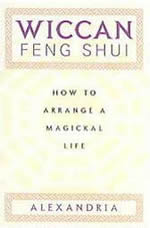Pagan Culture - Interviews
Celtic Devotional: Daily Prayers and Blessings
 Celtic Devotional:
Celtic Devotional:
Daily Prayers and Blessings
by Caitlin Matthews
Fair Winds Press, 2004
Four years ago when I began my Ninth Wave studies (www.lunaea.com – see review in SageWoman #67), one of the first lessons involved discovering the power of prayer.
Holy Mother


Holy Mother
by Archer
 The Sistine Madonna by Raphael ©2008 clipart.com
The Sistine Madonna by Raphael ©2008 clipart.comMy great-grandmother’s print of Raphael’s Sistine Madonna hangs in the closet where I keep my altar. The Virgin steps barefoot on the earth, her mantle blowing back from her face, her serious little son cradled easily to one side. She looks out, her expression unreadable. She seems younger than me, and yet so much wiser.
I’ve been praying to her.
I’ve been Pagan for many years, but somehow this image has never lost its appeal. In a way, such unorthodox prayer is typically Pagan, reflecting both the flexibility of Pagan spiritual practice and the diversity of Pagan origins. For while ancient Paganism certainly influenced Christianity, the reverse is true as well. As Christians drew from ancient cult when they built up the figure of the Virgin Mary (sparsely depicted in the Gospels), so modern Pagans draw from the emotional resonance of the Virgin’s story to shape their own version of the Goddess. It is that resonance that draws me, a quality that doesn’t feel Christian or Pagan, just deeply, mysteriously human.
Rocking the Goddess: Campus Wicca for the Student Practitioner
 Rocking the Goddess:
Rocking the Goddess:
Campus Wicca for the Student Practitioner
by Anthony Paige
Citadel Press

This one really surprised me by being such an excellent read: it’s almost Drawing Down the Moon for the college student. The author has interviewed college students practicing Wicca, professors of religious studies, and even the spooked parent of a Wiccan college student. But he doesn’t present this in a dry, please-recite-to-me-your-thoughts-on-Wicca style, instead, he’s simply relating anecdotes, conversation, and stories about real people, not Big Name Pagans.
Read more: Rocking the Goddess: Campus Wicca for the Student Practitioner
Wiccan Wisdom Keepers
 Wiccan Wisdom Keepers
Wiccan Wisdom Keepers
by Sally Griffin
Red Wheel/Weiser

Wiccan Wisdom Keepers by Sally Griffin is a beautiful book packed with glossy pages and full-color pictures, worthwhile for that alone. However, as the saying goes, you can’t judge a book by its cover — or in this case, photographs. The true value of Griffin’s book lies in the text itself.
Wiccan Feng Shui: How to Arrange a Magickal Life
 Wiccan Feng Shui:
Wiccan Feng Shui:
How to Arrange a Magickal Life
by Alexandria
Citadel Press

In Wiccan Feng Shui, How to Arrange a Magical Life, Alexandria has written a useful, highly readable book. She has interwoven Wiccan practices and tools with the traditional Feng Shui system in an interesting manner, creating a helpful combination of the two disciplines specifically designed for practitioners of Wicca.
Being Druid Today

Being Druid Today
by John Michael Greer
The original Druids, the priestly caste of ancient Celtic peoples in Britain, Ireland, and Gaul, went extinct more than a millennium ago. Very little information about them survived the centuries: a few scrappy second- and third-hand references in Greek and Roman texts, a few stories in Irish legends written down centuries after the coming of Christianity, and the ambiguous testimony of archaeology. Despite generations of hard work by scholars and archaeologists, the honest answer to most questions about the ancient Druids is still “we don’t know.”
For 300 years, though, the meager heritage of the ancient Druids has inspired people to follow a Druid path themselves. The historical setting of the Druid Revival makes it easy to understand why: the time of modern Druidry’s emergence also saw the Industrial Revolution, and the triumph of an ideology that sees nature purely as a source of raw materials and a place to dump waste.
From the dawn of the eighteenth century on, those who set out to craft a spirituality and a way of life in harmony with nature, found in the ancient Druids a potent symbol of their hopes. The image of a priest-hood of nature, worshipping in oak groves and stone circles beneath the open sky, inspired pioneering Druids such as John Toland and William Stukeley to propose a nature-centered Druidry profoundly relevant to the modern age. The result was the Druid Revival — a movement of nature spirituality which has flourished now for 300 years. This movement is inspired by the ancient Druids but draws freely on many spiritual traditions from around the world, united by a passionate reverence for the living Earth and a tradition of tolerance within which Druids of many different paths can work and worship together in peace. This vision of Druidry still guides many Druids today, and has deep roots in the cultural imagination of the Western world.
More Articles...
- The Pagan Mysteries of Halloween: Celebrating the Dark Half of the Year
- Living At Loki’s Feet
- Dark Moon Mysteries: Wisdom, Power and Magic of the Shadow World
- Goddess Initiation: A Practical Celtic Program for Soul-Healing, Self-Fulfillment & Wild Wisdom
- Exploring Wicca: The Beliefs, Rites, and Rituals of the Wiccan Religion
- A Witch Like Me















